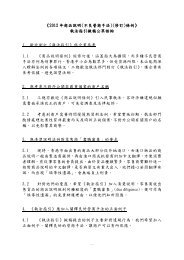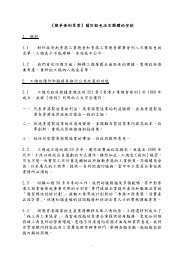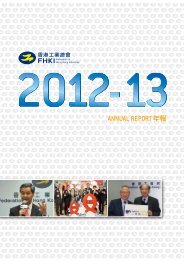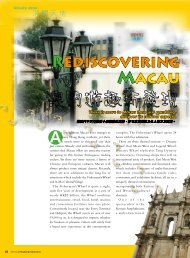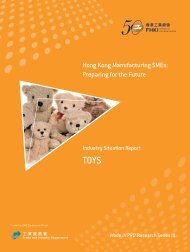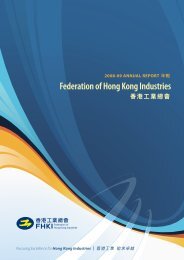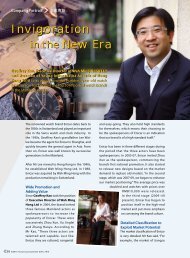Hong Kong Manufacturing SMEs: Preparing for the Future
Hong Kong Manufacturing SMEs: Preparing for the Future
Hong Kong Manufacturing SMEs: Preparing for the Future
- No tags were found...
You also want an ePaper? Increase the reach of your titles
YUMPU automatically turns print PDFs into web optimized ePapers that Google loves.
69China’s Labour Contract Law is not differentiallyapplicable at an industry level, but it is clear that <strong>the</strong>new law will increase manufacturing costs becauseof <strong>the</strong> requirement that firms provide additionalworker benefits. This will have <strong>the</strong> greatest impacton labour intensive industries, meaning that <strong>the</strong>effect on <strong>the</strong> garment sector is likely to be morepronounced than on many o<strong>the</strong>rs. 133At <strong>the</strong> end of 2008 <strong>the</strong> State Council introduceda “Plan on Adjusting and Revitalising <strong>the</strong> Textilesand Garment Industry” to help <strong>the</strong> Chinesegarment industry to overcome <strong>the</strong> global economicdownturn. 134 This Plan has helped <strong>the</strong> industry inMainland China raise finances and improve <strong>the</strong>irtechnological capabilities. Raising <strong>the</strong> tax rebaterate <strong>for</strong> textile exports, providing subsidies, andpostponing social insurance payments has improved<strong>the</strong> textile companies’ cash flows.The NDRC Plan <strong>for</strong> <strong>the</strong> PRD and related policies haveput pressure on garment firms, particularly thosethat do contract manufacturing, to move elsewherein Guangdong, move out of Guangdong altoge<strong>the</strong>r,and/ or move into ODM and OBM as a means ofadding greater value. The Guangdong Governmentintroduced a “double-transfer initiative” in 2008 135to encourage companies in <strong>the</strong> Pearl River Deltaregion to relocate <strong>the</strong>ir labour-intensive productionfacilities to less developed regions in <strong>the</strong> East, West,and North of <strong>the</strong> Province where <strong>the</strong>re is readilyavailable local labour.The relocation of a garment factory is less difficultthan o<strong>the</strong>r industries due to <strong>the</strong> simple natureof <strong>the</strong> machinery and production processesinvolved. Their requirement <strong>for</strong> local servicesis also lower than o<strong>the</strong>r industries and <strong>the</strong>irsimpler supply chain means that may not also benecessary to move <strong>the</strong>ir upstream suppliers aswell. Never<strong>the</strong>less, <strong>the</strong> garment industry has along processing and supply chain where <strong>the</strong> PRDstill has advantages. The PRD can provide fast andreliable delivery <strong>for</strong> garments products as it hasestablished a very good supply chain and flexibleservices system. The logistics costs will increaseif <strong>the</strong> garment factories move outside of <strong>the</strong>garment manufacturing cluster.While <strong>Hong</strong> <strong>Kong</strong> firms’ ability to manageproduction in South China is still an advantage,competition with o<strong>the</strong>r areas of China will heat up.There will be challenges associated with movingproduction into new areas of China. Moving deeperinto China’s interior dilutes executive control from<strong>Hong</strong> <strong>Kong</strong>. It also may bring executives into moredirect competition with strong local manufacturers,and require <strong>the</strong>m to deal with local governmentsless aligned with <strong>the</strong>ir export oriented activities.In addition, international sourcing operationstraditionally focused on <strong>Hong</strong> <strong>Kong</strong> and <strong>the</strong> PearlRiver Delta will diversify <strong>the</strong>ir supply locations inChina.Response Strategies of <strong>Hong</strong> <strong>Kong</strong> <strong>SMEs</strong>The sharp decline in <strong>Hong</strong> <strong>Kong</strong> domestic garmentexports suggests that <strong>the</strong> industry in <strong>Hong</strong> <strong>Kong</strong>suffered greater losses than in many o<strong>the</strong>r locationsas a result of <strong>the</strong> global economic crisis and it mayalso point to an acceleration of moves by remainingfirms to relocate garment manufacturing to <strong>the</strong>Chinese Mainland. For firms already in <strong>the</strong> PRD,moving to less developed parts of Guangdongmay reduce labour costs and allow <strong>the</strong>m to findsemi-skilled workers, but may impose difficultiesin finding and retaining skilled technicians andmanagement, as well as increase supply costs and<strong>the</strong> cost of shipping finished products.133 China Statistical Yearbook 2009, calculated ratio of GIO toEmployment134 www.lawinfochina.com.135 www.newsgd.com.




